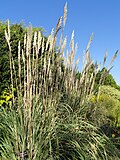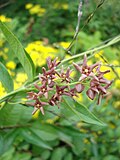Description
Invasive species are often grouped by threat levels that vary from county to county from very high impact to remarkable increased growth. The species below are by no means comprehensive and are listed in type order rather than level of threat [1] [2] [3]
The Pennsylvania Department of Conservation and Natural Resources ranks invasive species into 3 categories based on urgency of threat. [4]
Terrestrial Plants and Trees
| Picture | Scientific Name | Common Name |
|---|---|---|
 | Acer platanoides | Norway maple |
 | Ailanthus altissima | tree of heaven |
 | Alliaria petiolata | garlic mustard |
 | Aralia elata | Japanese Angelica tree |
| Berberis thunbergii | Japanese barberry | |
 | Euonymus alatus | Winged Spindle |
 | Lonicera japonica | Japanese honeysuckle |
 | Phragmites | |
 | Reynoutria japonica | Japanese knotweed |
 | Rhamnus cathartica | Buckthorn |
 | Rhodotypos scandens | Jetbead |
 | Rosa multiflora | Multiflora Rose |
 | Rubus phoenicolasius | Japanese wineberry |
 | Saccharum ravennae | Ravenngrass |
 | Frangula alnus | Alder Buckthorn |
 | Galega officinalis | goat's-rue |
 | Heracleum mantegazzianum | Giant Hogweed |
 | Phellodendron | Cork-Tree |
 | Pueraria | Kudzu |
 | Vincetoxicum nigrum | Black Swallowwort |
 | Vincetoxicum rossicum | Pale Swallowwort |
 | Morus alba | White Mulberry |
